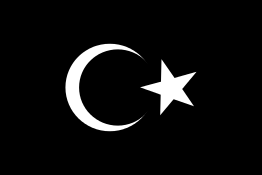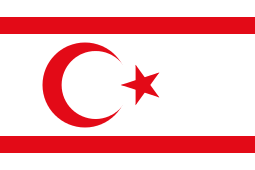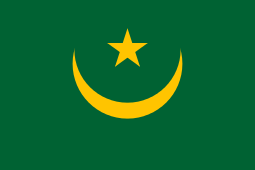Flag of Turkey
 | |
| Use | National flag and ensign |
|---|---|
| Proportion | 2:3 |
| Adopted | 1844 |
| Design |
A red field with a white star and crescent slightly left of center.[1] PAN: 186C RGB: 227, 10, 23 HEX: #E30A17 |
|
Variant flag of Turkey | |
| Name | Presidential flag of Turkey |
| Use | Other |
| Proportion | 2:3 |
|
Variant flag of Turkey | |
| Name | Flag of the Customs Administration |
| Use | Other |
| Proportion | 2:3 |
|
Variant flag of Turkey | |
| Name | Flag of the Commander-in-Chief of the Turkish Armed Forces. |
| Use | Other |
| Proportion | 1:1 |
The flag of Turkey (Turkish: Türk bayrağı) is a red flag featuring a white star and crescent. The flag is often called al bayrak (the red flag), and is referred to as al sancak (the red banner) in the Turkish national anthem.
The current design of the Turkish flag is directly derived from the late Ottoman flag, which had been adopted in the late 18th century and acquired its final form in 1844.
The measures, geometric proportions, and exact tone of red of the flag of Turkey were legally standardized with the Turkish Flag Law on May 29, 1936.[2]
History
The star and crescent design appears on Ottoman flags beginning in the late 18th or early 19th century. The introduction of the white star and crescent on red as the flag of the Ottoman Empire dates to the Tanzimat reforms of 1844.
Legendary origins
In accounting for the crescent and star symbol, Ottomans sometimes (1890) referred to a legendary dream of the eponymous founder of the Ottoman house, Osman I, in which he is reported to have seen a moon rising from the breast of a qadi whose daughter he sought to marry. "When full, it descended into his own breast. Then from his loins there sprang a tree, which as it grew came to cover the whole world with the shadow of its green and beautiful branches." Beneath it Osman saw the world spread out before him, surmounted by the crescent.[3] The real legend: Turks fought a legendary bloody battle. It was so bloody that a shallow lake of blood was formed. Survivors of the battle saw that moon and stars shined over the blood. Red on the flag is the blood of matryrs.
Legal basis
Fundamentals of the Turkish flag dated 1844 were laid down by Turkish Flag Law No. 2994 on May 29, 1936 during the Republic period of Turkey. Turkish Flag Regulation No. 2/7175 dated July 28, 1937, and Supplementary Regulation No. 11604/2 dated July 29, 1939, were enacted to describe how the flag law would be implemented. The Turkish Flag Law No. 2893 dated September 22, 1983, and Published in the Official Gazette on September 24, 1983, was promulgated six months after its publication. According to Article 9 of Law No. 2893, a statute including the fundamentals of the implementation was also published.
Construction
Colours
In an RGB colour space, the red colour of the Turkish flag is composed of 89% red, 3.9% green, and 9% blue (in hexadecimal colour code #E30A17). In a CMYK colour space, it is composed of 0% cyan, 95.6% magenta, 89.9% yellow and 11% black. It has a hue angle of 356.4 degrees, a saturation of 91.6%, and a lightness of 46.5%. The red colour on the Turkish flag is vivid red and this colour can be obtained by blending #FF142E with #C70000. The closest websafe colour is: #d11919.
Dimensions

| Letter | Measure | Length |
|---|---|---|
| G | Width | |
| A | Distance between the centre of the outer crescent and the seam of the white band | 1⁄2 G |
| B | Diameter of the outer circle of the crescent | 1⁄2 G |
| C | Distance between the centres of the inner and outer circles of the crescent | 1⁄16 G |
| D | Diameter of the inner circle of the crescent | 2⁄5 G |
| E | Distance between the inner circle of the crescent and the circle around the star | 1⁄3 G |
| F | diameter of the circle around the star | 1⁄4 G |
| L | Length | 1 1⁄2 G |
| M | Width of the white hem at the hoist | 1⁄30 G |
- The above specification, given by Turkish Flag Law, implies that the distance between (the left edge of) the inner circle of the crescent and a vertical line connecting the two pointed ends of the crescent is 279⁄800 G = 0.34875 G; thus, the left point of the star intrudes about 0.0154 G beyond that line.
A common mistake in rendering the flag is to omit the white hem at the hoist (the left side).
Flags under direct or partial influence
 Flag of Algeria
Flag of Algeria Flag of Azerbaijan
Flag of Azerbaijan Flag of Cyrenaica
Flag of Cyrenaica Flag of East Turkestan
Flag of East Turkestan Flag of Hatay State
Flag of Hatay State Flag of Libya
Flag of Libya Flag of Northern Cyprus
Flag of Northern Cyprus Flag of Malaysia
Flag of Malaysia Flag of Mauritania
Flag of Mauritania Flag of Ottoman Empire
Flag of Ottoman Empire Flag of Pakistan
Flag of Pakistan Flag of Tunisia
Flag of Tunisia Flag of Turkmeneli
Flag of Turkmeneli Flag of Umm al-Quwain
Flag of Umm al-Quwain Flag of Aceh Sultanate
Flag of Aceh Sultanate
Notes and references
- ↑ http://mevzuat.meb.gov.tr/html/18171_0.html
- ↑ "Türk Bayrağı Kanunu" [Law on Turkish Flag]. Turkish Historical Society.
- ↑ Lord Kinross, The Ottoman Centuries: The Rise and Fall of the Turkish Empire, Morrow Quill Paperbacks, 1977, pp 23-24.
External links
| Wikimedia Commons has media related to Flags of Turkey. |
- Türk Bayrağı Kanunu, the Turkish text of the Turkish Flag Law No. 2893 dated September 22, 1983, establishing the proportions, production, and rules of usage of the flag of Turkey
- Turkey at Flags of the World



